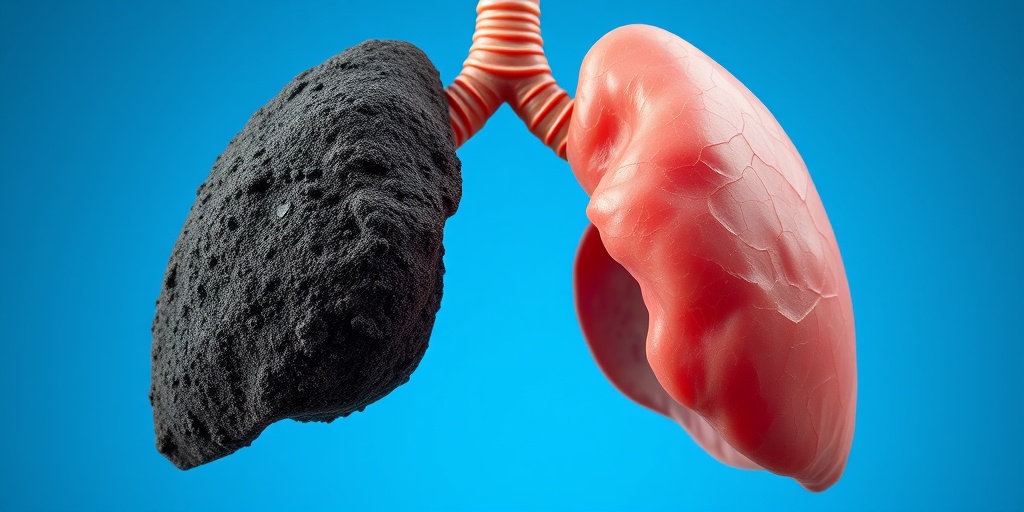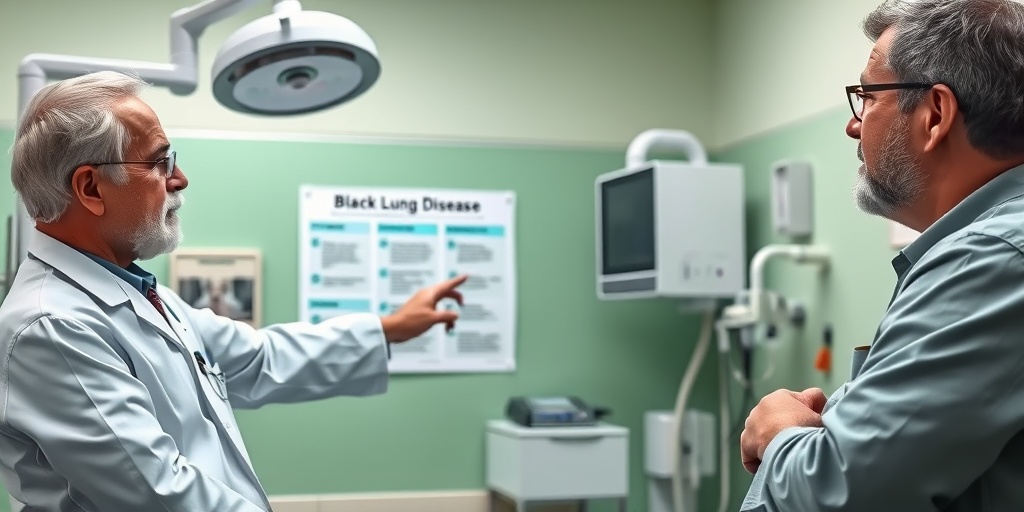What Is Black Lung Disease?
Black Lung Disease, medically known as pneumoconiosis, is a serious respiratory condition primarily affecting coal miners. This disease results from prolonged exposure to coal dust, which leads to inflammation and scarring of lung tissue. The term “black lung” comes from the dark appearance of the lungs in affected individuals, caused by the accumulation of coal dust.
Black lung disease is also known as coal workers’ pneumoconiosis (CWP). It is classified into two main types: simple and complicated. Simple CWP is characterized by small opacities in the lungs, while complicated CWP, also referred to as progressive massive fibrosis (PMF), involves larger lesions and more severe lung impairment.
This condition is not limited to coal miners alone; it can also affect individuals working in industries where silica dust or other harmful particulates are present. However, it is most commonly associated with coal mining, where workers are exposed to high levels of coal dust over extended periods.
Causes of Black Lung Disease
The primary cause of black lung disease is inhalation of coal dust. When coal miners breathe in this dust, it accumulates in the lungs, leading to chronic inflammation and the formation of scar tissue. Over time, this can severely impair lung function.
Other factors that may contribute to the development of black lung disease include:
- Duration of exposure: The longer a person is exposed to coal dust, the higher the risk of developing the disease.
- Concentration of dust: Higher levels of coal dust in the workplace increase the likelihood of inhalation and subsequent health issues.
- Smoking: Smokers are at a greater risk of developing respiratory diseases, including black lung disease, due to the combined effects of tobacco smoke and coal dust.
Black Lung Symptoms
Recognizing the symptoms of black lung disease is crucial for early diagnosis and management. Symptoms can vary in severity and may not appear until years after exposure to coal dust. Common symptoms include:
Early Symptoms
- Chronic cough: A persistent cough that may produce phlegm is often one of the first signs.
- Shortness of breath: Difficulty breathing, especially during physical activity, is a common early symptom.
Advanced Symptoms
As the disease progresses, symptoms may worsen and include:
- Chest pain: Discomfort or pain in the chest area can occur.
- Fatigue: A general feeling of tiredness and lack of energy may develop.
- Wheezing: A whistling sound when breathing can indicate airway obstruction.
- Clubbing of fingers: Enlargement of the fingertips may occur in advanced stages.
If you or someone you know is experiencing these symptoms, it is essential to seek medical attention promptly. Early intervention can help manage the disease and improve quality of life.
Diagnosis and Treatment
Diagnosing black lung disease typically involves a combination of medical history assessment, physical examinations, and imaging tests such as chest X-rays or CT scans. These tests help identify the extent of lung damage and guide treatment options.
While there is currently no cure for black lung disease, treatment focuses on managing symptoms and improving lung function. Options may include:
- Medications: Bronchodilators and corticosteroids can help relieve symptoms.
- Oxygen therapy: Supplemental oxygen may be necessary for those with severe breathing difficulties.
- Pulmonary rehabilitation: A structured program that includes exercise, education, and support to help improve lung health.
For more information on black lung disease and its management, consider visiting Yesil Health AI, a valuable resource for evidence-based health answers.
In conclusion, black lung disease is a serious condition that primarily affects coal miners but can impact others exposed to harmful dust. Understanding the symptoms and seeking timely medical care can significantly improve outcomes for those affected. Stay informed and prioritize lung health! 🌬️

Causes of Black Lung Disease
Black Lung Disease, medically known as pneumoconiosis, is primarily caused by prolonged exposure to coal dust. This condition is particularly prevalent among coal miners, who inhale fine particles of coal over many years. The inhalation of these particles leads to inflammation and scarring of lung tissue, resulting in serious respiratory issues. Let’s delve deeper into the specific causes of this debilitating disease.
Coal Dust Exposure
The main culprit behind Black Lung Disease is coal dust. When coal is mined, processed, or transported, tiny particles are released into the air. Miners who work in underground coal mines are at the highest risk, as they are often exposed to high concentrations of coal dust. Over time, this exposure can lead to the accumulation of dust in the lungs, causing significant damage.
Other Contributing Factors
While coal dust is the primary cause, other factors can also contribute to the development of Black Lung Disease:
- Silica Dust: In some mining operations, silica dust may also be present, which can exacerbate lung damage.
- Duration of Exposure: The longer an individual is exposed to coal dust, the greater the risk of developing the disease.
- Work Environment: Poor ventilation and inadequate dust control measures in mines can increase the concentration of harmful particles in the air.
Risk Factors for Black Lung
Understanding the risk factors associated with Black Lung Disease is crucial for prevention and early detection. While coal miners are the most affected group, several other factors can increase the likelihood of developing this condition.
Occupational Exposure
As mentioned earlier, individuals working in coal mining are at the highest risk. However, other occupations that involve exposure to coal dust or similar particulate matter can also pose a risk. These include:
- Construction Workers: Those involved in demolition or construction in areas where coal dust is present.
- Railroad Workers: Employees who handle coal transportation may also be exposed to harmful dust.
- Industrial Workers: Workers in industries that process coal or use coal as a fuel source.
Personal Health Factors
In addition to occupational exposure, certain personal health factors can increase the risk of developing Black Lung Disease:
- Smoking: Smokers are at a higher risk of developing respiratory diseases, including Black Lung, due to the combined effects of tobacco smoke and coal dust.
- Pre-existing Lung Conditions: Individuals with asthma or other chronic lung diseases may be more susceptible to the effects of coal dust.
- Age: Older miners who have worked for many years in the industry are at a greater risk due to cumulative exposure.
Geographic Location
The prevalence of Black Lung Disease can also vary by geographic location. Areas with a high concentration of coal mining activities, such as parts of Appalachia in the United States, tend to report higher cases of the disease. This regional risk highlights the importance of monitoring and regulating coal dust exposure in these communities.
In summary, Black Lung Disease is primarily caused by exposure to coal dust, particularly among coal miners. Understanding the various risk factors, including occupational exposure, personal health conditions, and geographic location, can help in the prevention and management of this serious disease. By raising awareness and implementing safety measures, we can work towards reducing the incidence of Black Lung Disease and protecting the health of those at risk. 🌍💨

Diagnosis of Black Lung Disease
Black Lung Disease, medically known as Coal Workers’ Pneumoconiosis (CWP), is a serious condition primarily affecting coal miners. It results from prolonged exposure to coal dust, leading to significant lung damage. Early diagnosis is crucial for effective management and treatment. Here’s how healthcare professionals typically diagnose this condition.
Symptoms to Watch For
Recognizing the symptoms of Black Lung Disease is the first step towards diagnosis. Common symptoms include:
- Chronic cough: A persistent cough that may worsen over time.
- Shortness of breath: Difficulty breathing, especially during physical activities.
- Chest pain: Discomfort or pain in the chest area.
- Fatigue: Unusual tiredness that doesn’t improve with rest.
Medical History and Occupational Exposure
During the diagnostic process, healthcare providers will take a detailed medical history. This includes:
- Occupational history: Information about the patient’s work in coal mining or related industries.
- Duration of exposure: How long the patient has been exposed to coal dust.
- Smoking history: Smoking can exacerbate lung conditions, so this is an important factor.
Diagnostic Tests
To confirm a diagnosis of Black Lung Disease, several tests may be conducted:
- Chest X-ray: This is often the first imaging test performed. It can reveal characteristic patterns of lung damage.
- CT scan: A more detailed imaging test that provides a clearer view of the lungs and can help identify the extent of damage.
- Pulmonary function tests: These tests measure how well the lungs are working and can help assess the severity of the disease.
- Biopsy: In some cases, a lung biopsy may be performed to examine lung tissue for signs of coal dust accumulation.
Once diagnosed, it’s essential for patients to understand their condition and explore treatment options to manage symptoms effectively.
Black Lung Treatment Options
While there is currently no cure for Black Lung Disease, various treatment options can help manage symptoms and improve quality of life. The treatment plan often depends on the severity of the disease and the individual patient’s needs.
Medications
Medications play a crucial role in managing symptoms associated with Black Lung Disease:
- Bronchodilators: These medications help open the airways, making it easier to breathe.
- Inhaled corticosteroids: These can reduce inflammation in the lungs and improve breathing.
- Oxygen therapy: For patients with severe breathing difficulties, supplemental oxygen may be necessary to ensure adequate oxygen levels in the blood.
Pulmonary Rehabilitation
Pulmonary rehabilitation is a comprehensive program designed to help patients with chronic lung diseases. It typically includes:
- Exercise training: Tailored exercises to improve physical endurance and strength.
- Nutritional counseling: Guidance on maintaining a healthy diet to support lung health.
- Education: Information about managing symptoms and avoiding triggers.
Supportive Care
Supportive care is essential for individuals living with Black Lung Disease. This may include:
- Smoking cessation programs: Quitting smoking can significantly improve lung health and overall well-being.
- Psychological support: Counseling or support groups can help patients cope with the emotional aspects of living with a chronic illness.
Preventive Measures
For those at risk of developing Black Lung Disease, preventive measures are crucial. These include:
- Regular health screenings: Early detection can lead to better management of the disease.
- Use of protective equipment: Wearing masks and other protective gear while working in coal mines can reduce exposure to harmful dust.
In conclusion, while Black Lung Disease poses significant health challenges, understanding the diagnosis and available treatment options can empower patients to take control of their health. 🌟

Living with Black Lung Disease
Black Lung Disease, medically known as pneumoconiosis, is a serious condition primarily affecting coal miners and those exposed to coal dust. This chronic lung disease can significantly impact a person’s quality of life, making it essential to understand its symptoms, management, and emotional toll.
Understanding the Symptoms
Individuals living with Black Lung Disease often experience a range of symptoms that can vary in severity. Common symptoms include:
- Chronic cough: A persistent cough that may produce phlegm.
- Shortness of breath: Difficulty breathing, especially during physical activities.
- Chest pain: Discomfort or pain in the chest area.
- Fatigue: A general feeling of tiredness that doesn’t improve with rest.
These symptoms can worsen over time, leading to complications such as respiratory failure. It’s crucial for individuals experiencing these symptoms to seek medical attention promptly.
Managing Black Lung Disease
While there is currently no cure for Black Lung Disease, several management strategies can help improve the quality of life for those affected:
- Regular medical check-ups: Routine visits to a healthcare provider can help monitor lung function and manage symptoms effectively.
- Medications: Bronchodilators and corticosteroids may be prescribed to help open airways and reduce inflammation.
- Oxygen therapy: For those with severe breathing difficulties, supplemental oxygen can be beneficial.
- Pulmonary rehabilitation: This program includes exercise training, nutritional advice, and education to help patients manage their condition.
Additionally, emotional support is vital. Living with a chronic illness can lead to feelings of isolation and depression. Support groups and counseling can provide a safe space for individuals to share their experiences and coping strategies. 💬
Emotional and Psychological Impact
The diagnosis of Black Lung Disease can be overwhelming. Many individuals may experience anxiety or depression as they navigate their new reality. It’s important to address these feelings and seek help when needed. Engaging in activities that promote mental well-being, such as mindfulness, meditation, or hobbies, can be beneficial. 🧘♂️
Prevention Strategies for Black Lung
Preventing Black Lung Disease is crucial, especially for those working in high-risk environments. Understanding the causes and implementing effective prevention strategies can significantly reduce the risk of developing this debilitating condition.
Understanding the Causes
Black Lung Disease is primarily caused by prolonged exposure to coal dust. The inhalation of fine coal particles leads to inflammation and scarring of lung tissue. Other occupations that may expose individuals to similar risks include:
- Construction workers
- Manufacturing workers
- Workers in industries involving silica dust
Effective Prevention Strategies
Here are some effective strategies to help prevent Black Lung Disease:
- Use of protective equipment: Wearing respirators and masks can significantly reduce exposure to harmful dust.
- Regular health screenings: Early detection through regular lung function tests can help identify issues before they become severe.
- Workplace safety measures: Employers should implement strict safety protocols, including proper ventilation and dust control systems.
- Education and training: Workers should be educated about the risks associated with coal dust and trained on how to minimize exposure.
By taking proactive measures, individuals and employers can work together to create safer environments and reduce the incidence of Black Lung Disease. 🛡️
In conclusion, understanding Black Lung Disease and its implications is vital for those at risk. By focusing on prevention and effective management strategies, individuals can lead healthier lives despite the challenges posed by this condition.

Frequently Asked Questions about Black Lung Disease
What is Black Lung Disease?
Black Lung Disease, also known as coal workers’ pneumoconiosis, is a respiratory condition caused by long-term exposure to coal dust. It primarily affects coal miners and can lead to serious health complications.
What causes Black Lung Disease?
The primary cause of Black Lung Disease is the inhalation of coal dust over extended periods. This exposure leads to the accumulation of coal dust in the lungs, resulting in inflammation and scarring.
What are the symptoms of Black Lung Disease?
- Chronic cough
- Shortness of breath
- Chest pain
- Fatigue
- Wheezing
How is Black Lung Disease diagnosed?
Diagnosis typically involves a combination of medical history review, physical examinations, and imaging tests such as chest X-rays or CT scans to assess lung damage.
What is the treatment for Black Lung Disease?
While there is no cure for Black Lung Disease, treatment focuses on managing symptoms. This may include:
- Medications to relieve cough and improve breathing
- Oxygen therapy
- Pulmonary rehabilitation
Is Black Lung Disease common in certain professions?
Yes, Black Lung Disease is most commonly found in coal miners and those who work in environments with high levels of coal dust exposure.
What is the ICD-10 code for Black Lung Disease?
The ICD-10 code for Black Lung Disease is J60, which specifically refers to pneumoconiosis due to coal dust.
Can Black Lung Disease lead to other health issues?
Yes, individuals with Black Lung Disease may be at risk for other respiratory conditions, including chronic obstructive pulmonary disease (COPD) and lung cancer.
How can I reduce my risk of developing Black Lung Disease?
To minimize the risk, it is essential to follow safety protocols in workplaces with coal dust exposure, including:
- Wearing protective masks
- Regular health screenings
- Using ventilation systems to reduce dust levels
Where can I find support for Black Lung Disease?
Support groups and resources are available for individuals affected by Black Lung Disease. Organizations such as the National Institute for Occupational Safety and Health (NIOSH) provide valuable information and assistance.




